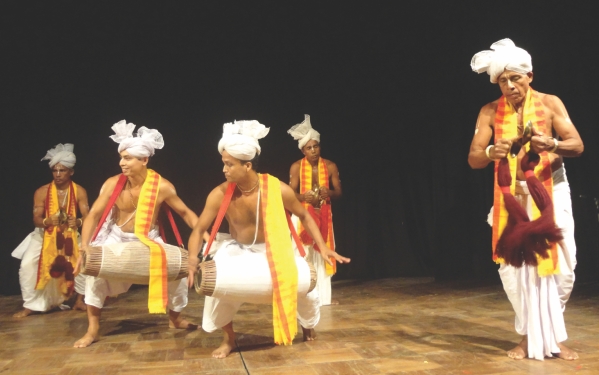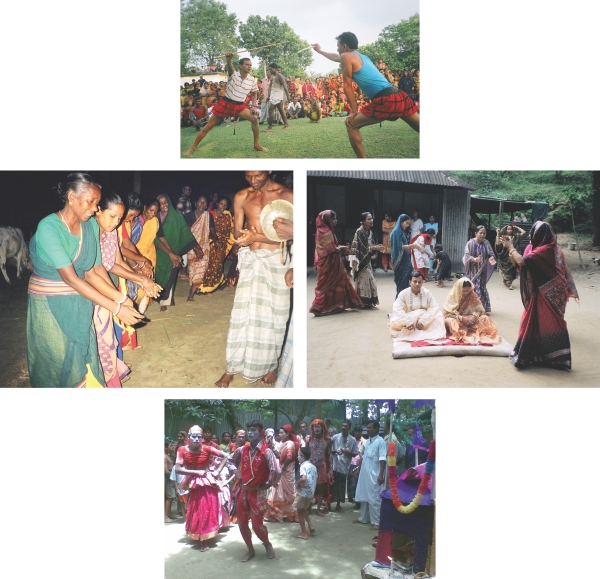Journey Through Bangladesh
Folkdances of Bangladesh
Native folkdance in its well-structured form has existed in rural Bangladesh from ancient times to now. We get a clear idea about most of the folkdance practices from sources in ancient Bengali literature to the carved terracotta on the sides of temples, and the posture of various architectural sculptures of the time, as well as from the middle ages literary perceptions, sculptures, terracotta carvings and paintings.
.........................................................................
Saymon Zakaria

A verse from the Charyapada narrated between sixth century AD to twelfth century AD reads:
'Ek so padma chowsotthi pakhuri
Tohi chori nacha Dombi bapuri.'
This is about a lotus which contains sixty four petals and the poor 'Dombi' who dances on it. In other words, Dombi's dance practices were so well-skilled that she could dance on a sixty-four petal lotus, as if she almost dissolved her body's weight by the motion of her dance. Even though literary scholars search for typical presentation of native Buddhist meditative methods through this verse, at the same time it is also true that devotees derive their meditative methods' nature from current experiences of their time.
I looked intently at the Sompura Bihar, and found it similar to the carved terracotta on the Buddha Bihar's temple in Paharpur, both being contemporary to the above 10th verse from the Charyapada written by Kanhupa, and was truly able to visualize a well-dressed, well-adorned female dancer dancing on the petals of a lotus. Examples of these dancing motions are also evident in the stroke-marks of the Charyapada's creators. There is another verse in The Charyapada:
'Nachonti Bajil Ganti Devi
Buddho Natok Bisoma Hoi'.
This means, the Vajracharya is dancing, the goddess is singing. The Buddho Natok is difficult. From this 17th verse from the Charyapada written by Binapa, we get a classic and impartial example of Bangladesh's theatrical dance and music customs. In fact, with the traditional Bengali dance practices, drama and music have been maintaining an undivided and impartial formation from the beginning.

If we look at the fifteenth-sixteenth century AD dance practices, presented then by Sri Chaitanya Mahaprabhu, we will find therein dance, drama and music present in a precisely defined form.
One day Chaitanya Mahaprabhu called his disciples and said, “I wish to dance today in an appropriate manner”. Not only that, he also ordered, “prepare and ordain accordingly as I shall dance. I shall dance as a female naturally does. And only those who have mastered all passions shall watch.” Pandit Sribhash argued, “I do agree but, if we must have mastered all passions in order to watch the dance, how many people will actually possess this?”
Chaitanya Mahaprabhu replied to his courtiers in merriment, “If you do not watch then, what is the purpose of my dance?” After that it seems the devotees went along with their families to see that performance by Chaitanya Mahaprabhu. By studying these in detail we can visualize a clear picture of the middle ages popular dance practices narrated in Bangla. It is also correct that when Chaitanya Mahaprabhu attempted to perform his dance with his disciples, along with songs, their performance included acts and dialogues as well.
We can surely relate our present traditional dances of Bangladesh to the Chaitanya Mahaprabhu's dance practices. That is because the contemporary Bengali dance, drama, music and the styles in which they are performed are all staged in similar presentations, and, these are somehow or other connected to those of our olden times. In which case, it may be mentioned that, most of our country's dance patterns includes music and, are related to the arrangements of our old myths. As a result, in maximum cases, our traditional dances are presented as musicals or theatrical plays. In some instances these performances are referred to as nach, nachon, nachari, although, many scholars identify them as theatrical plays. That is because, even though the elements of dances are prime focus, when the elements of drama are added to the work, it would not be incorrect to call them plays. But, other than with music which is based on both rhythm and lyric, or, dialogue based plays, there still exist some pure traditional dances which are performed with the aid of rhythms alone.
Among traditional dances of Bangladesh we have: Jari nach, Dhamail nach, Lathi nach, Padmar nachon, Behular nachari, Baiddar nach, Kali nach, Dondo nach etc, some of which are shown in the photographs. Furthermore, with traditional drama of Bangladesh, many varied types of dances are added, like: the traditional Alkap type dances, Gombhira, Gajir gaan, Kushan gaan, Astok gaan, Royani gaan, Naamkirtan and Padabali kirtan etc. Apart from this, there is Monipuri, Shantal, Orayun, Hajang, Chakma, Marma, Tripura, Rakhain and many more dancer groups' work and, festival dances may also be noteworthy.
Copyright
(R) thedailystar.net 2012 |
|


